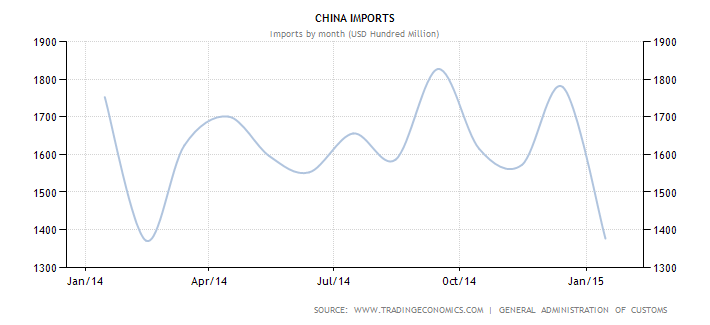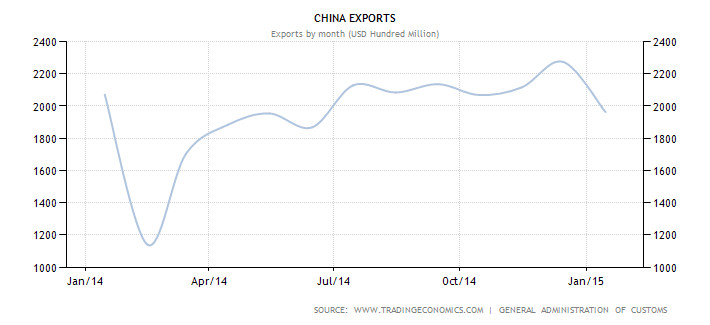The January trade figures from China are a stunner – an unexplained near 20% slide in imports and exports down 3.3%, as it appeared the most important economy for Australia had experienced a sharp slide in the level of demand and economic activity.
As a result, China recorded a record trade surplus of $US60 billion – nearly 50% higher than the monthly surpluses reported in the last quarter of 2014.
The falls in imports and exports were far greater than any forecast by analysts before the release of the data.
The big worry was the slide in imports which was the sharpest since May, 2009, when Chinese factories were still slashing inventories in reaction to the GFC.
Reuters said “The dismal trade performance will increase concerns that an economic slowdown in China – originally considered a desirable adjustment away from an investment-intensive export model toward one based on domestic consumption – is at risk of derailing.”
China’s imports slump

The data follows the surprise move last week to cut the required reserve ratio for banks which will make over $US100 billion available for lending.
Contributing to the record surplus was a sharp fall imports – particularly of key commodities such as iron ore, coal, oil.
Part of the fall can be attributed to the sharp fall in the prices of some commodities in January, especially oil, iron ore and copper – though both oil and iron ore had been falling since midway through last year.
Volumes were also down sharply as well, which added to the size of the surplus.That meant for Australia, there were a couple of bits of bad news – lower imports of iron ore and coal in January.
China’s iron ore imports fell from the record high in December to 78.57 million tonnes, compared with 86.85 million in December and 86.83 million in January 2014 (one of the few times in recent years that there has been a fall year on year).
That was just above the monthly average for 2014 of 77.71 million tons a month in 2014, when imports hit a 12 month record of 932.51 million.
Total copper imports dropped 20% in January to 930,000 tonnes (from December), according to General Administration of Customs data released Sunday. Imports of unwrought copper and products dropped for the first time in five months to 410,000 tonnes, down 25% from the same month in 2013. That’s despite the sharp fall in copper prices in the month, which has usually seen Chinese buyers stock up.
Coal imports dropped nearly 40% to 16.78 million tonnes, from December’s 27.22 million tonnes, and crude oil imports, slid 7.9% in volume terms to27.98 million tonnes, or 6.59 million barrels a day, in January, 0.6% below year ago levels and nearly 8% below December’s level.
Imports from Australia and the Russia, both major commodity suppliers, slid by 35.3% and 28.7%, respectively. For Australia, the falls, especially in iron ore, is pointing to a weak trade report for January in a month’s time.
The export performance was scatty as well – While shipments to the US rose 4.8% in January, they fell 4.6% to the European Union. And exports to Hong Kong and South Korea and were also down, with exports to Japan slumping over 20%.
China’s exports also post surprise drop

Comment: Now these weak trade figures are serious – but working out just how serious will take time – two to three months. The only explanation from the government was the usual disruptions caused by the Lunar New Year and Spring festival. But another month with figures even close to these, especially imports, and analysts will start concluding the Chinese economy is tanking.
That was a pretty weak excuse given the plunge in the level of commodities and the fall in exports. The Lunar New Year/Spring Festival is timed for next week and runs for seven days.
It is why the Chinese government quite often lumps together economic data such as urban investment, retail sales and output for January and February to try and smooth out that impact of the long break.
Usually when the long holiday falls in February, Chinese companies import more and export more in January to make up for the dislocation caused to be caused by the break, thereby boosting export and import figures for January. That is what has happened in past years when the break has fallen in February.
But not this year, according to the data released yesterday in Beijing. if that wasn’t such a dominant factor as in previous years, we can only conclude that Chinese companies cut back on imports because they finished 2014 heavily overstocked and didn’t need to import extra raw materials. That could mean the next few months will see weak import data from China.
And there is a final point to be made about the worrying nature of the data released yesterday.Last year the new year holiday idled factories and financial markets for a week in January, but with the holiday in mid to late February, January was a full month of business as usual, so imports should have been at more believeable levels.
February’s data will be impacted by the holidays, so it won’t be March and April before we can get an accurate picture of how the economy is travelling and especially imports.
If not reversed in coming months, the fall in imports would have us believe the Chinese economy has suddenly slowed very sharply – which is not what other reports have suggested – the falls in the two start of month surveys of manufacturing showed small drops in activity – but not the sort that would fit the narrative of a near 20% drop in imports.













